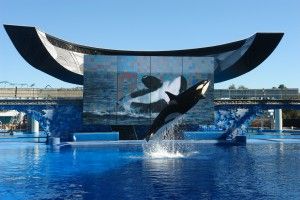SeaWorld to drop San Diego orca shows
by James Poulos | November 13, 2015 9:02 am
 [1]Scrambling to salvage its business amid a wave of negative publicity, SeaWorld has scrapped its traditional orca shows, banking on shaky hopes that the move is enough to turn the tide of criticism.
[1]Scrambling to salvage its business amid a wave of negative publicity, SeaWorld has scrapped its traditional orca shows, banking on shaky hopes that the move is enough to turn the tide of criticism.
Trying for a reboot
“In 2017 we will launch an all new orca experience” focused on the whales’ “natural environment,” SeaWorld CEO Joel Manby recently announced[2], according to the Guardian. “2016 will be the last year of our theatrical killer whale experience in San Diego.” But the traditional performances will continue at SeaWorld’s other locations in Texas and Florida.
“He said the decision to end the orca shows in California was in direct response to customers, who he said had made it clear that they want less of a theatrical experience and would rather see the whales in a more natural setting,” the Guardian added. “Attendance at the San Diego park is falling fast. Visitor numbers dropped 17 percent last year to 3.8 million, according to city authorities, and Manby warned investors last week that numbers are still falling and would contribute to a $10 million hit to SeaWorld’s profits this year.”
Activists and critics, to little surprise, welcomed the change but swiftly demanded more. “Animal rights activists applauded SeaWorld’s plans to end its orca shows at its San Diego park but said the company should phase out its captivity of killer whales altogether,” the Associated Press reported[3].
Growing opposition
The root of the crisis traced back to the debut two years ago of a harshly critical documentary film. “Attendance has plunged, and company shares have fallen in half, since the 2013 documentary ‘Blackfish’ made a compelling case that the confinement and exploitation of killer whales inflicted physical and psychological stress on creatures that thrive on socialization and vast expanses of the ocean,” as the editorial board of the San Francisco Chronicle noted[4]. Tim Zimmerman, co-writer of the film, told[5] CNN SeaWorld’s abandonment of the San Diego shows was a “first step.”
“That film, shown repeatedly on CNN, had a profound impact on how the theme park is percieved by the public. SeaWorld has spent millions of dollars on ads and social media to restore its reputation,” as NPR observed[6]. ‘Blackfish’ took as its point of departure the 2010 death of SeaWorld trainer Dawn Brancheau, killed by one of the captive orcas at the company’s Florida location. SeaWorld withdrew its trainers from orca tanks after the incident, NPR added; but the damage to its reputation was done, as activists began to focus in on its treatment of whales and the psychology of the animals in captivity.
Legislators and regulators have also chipped away at the company’s fortunes. “SeaWorld suffered another blow last month when the California Coastal Commission approved a SeaWorld plan to expand its orca enclosures in San Diego but added the condition that the park must end its killer whale breeding program and halt the transfer of new whales to the park,” the Los Angeles Times recalled[7]. “The conditions would eventually put an end to the park’s most popular attraction.”
Meanwhile, Rep. Adam Schiff, D-Calif., has forged ahead with a plan to federally prohibit the captive breeding of orcas. “The fact still remains that as long as SeaWorld holds orcas in captivity, the physical and psychological problems associated with their captivity will persist,” he said, according to the AP.
Added troubles
In a grim irony, SeaWorld’s troubles have not been confined to their featured marine animals. “A Wilsonville man is suing SeaWorld in San Diego, California after a trained hawk attacked his service dog,” KATU reported[8]. “His dog may have contracted an aggressive disease as a result. Robin Revel has mounting veterinarian bills for his service dog Yogi that he didn’t expect after the attack happened in February. That’s why his attorney e-filed the liability lawsuit in San Diego on Wednesday.”
- [Image]: http://calwatchdog.com/wp-content/uploads/2015/10/SeaWorld.jpg
- announced: http://www.theguardian.com/us-news/2015/nov/09/seaworld-end-orca-whale-shows-san-diego
- reported: http://www.cbs8.com/story/30492952/activists-say-ending-seaworld-orca-shows-not-enough
- noted: http://www.sfchronicle.com/opinion/editorials/article/SeaWorld-takes-first-step-toward-restoring-image-6623393.php
- told: http://www.cnn.com/videos/world/2015/11/09/seaworld-no-more-killer-whale-shows-blackfish-co-writer-intv-walker-cnn-today.cnn/video/playlists/top-news-videos/
- observed: http://www.npr.org/2015/11/11/455657424/seaworld-reinvents-itself-in-face-of-growing-blackfish-scrutiny
- recalled: http://www.latimes.com/business/la-fi-seaworld-fights-back-20151106-story.html
- reported: http://www.katu.com/news/local/Wilsonville-man-sues-SeaWorld-in-San-Diego-after-hawk-attacked-service-dog-346456852.html
Source URL: https://calwatchdog.com/2015/11/13/seaworld-drop-san-diego-orca-shows/